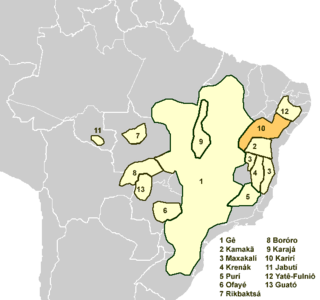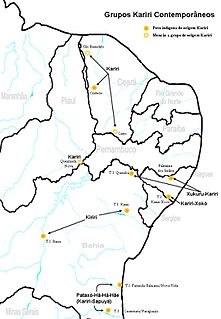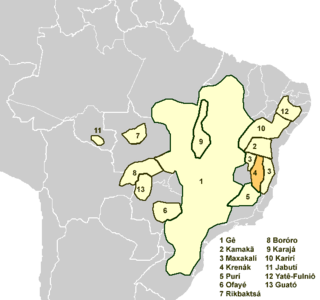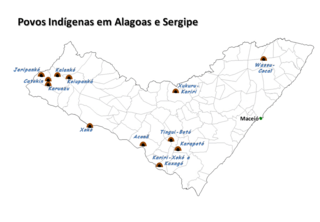Related Research Articles

The Maxakalían languages were first classified into the Jê languages. It was only in 1931 that Loukotka separated them from the Jê family. Alfred Métraux and Curt Nimuendaju Unkel considered the Maxakalían family isolated from others. John Alden Mason suggests a connection with the Macro-Jê stock, confirmed by Aryon Dall’Igna Rodrigues.
The Cahuapanan languages are a language family spoken in the Amazon basin of northern Peru. They include two languages, Chayahuita and Jebero, which are spoken by more than 11,300 people. Chayahuita is spoken by most of that number, but Jebero is almost extinct.
Yurumanguí is an extinct language that was spoken along the Yurumanguí River of Colombia. It is known only through a short list of words and phrases recorded by Father Christoval Romero and given by him to Captain Sebastián Lanchas de Estrada, who included them in the report of his travels of 1768. Thereafter the language and its speakers disappear from the historical record.

The Karirí languages, generally considered dialects of a single language, are extinct languages formerly spoken by the Kiriri people of Brazil. It was spoken until the middle of the 20th century; the 4,000 ethnic Kiriri are now monolingual Portuguese speakers, though a few know common phrases and names of medicinal plants.

Banzaê is a municipality in the state of Bahia in the North-East region of Brazil.

Kiriri people are indigenous people of Eastern Brazil. Their name is also spelled Cariri or Kariri and is a Tupi word meaning "silent" or "tactiturn."

The Aimoré or Botocudoan languages, now sometimes known as Krenakan after the last one remaining, are a branch of the Macro-Jê languages, including moribund Krenak and extinct languages such as Guerén and Nakrehé. Loukotka (1968) considered them dialects of a single language, but more recent treatments describe at least some of them as separate languages.

The Kamakã languages are a small family of extinct Macro-Jê languages of Bahía near Brazil's Atlantic coast. The attested Kamakã languages are:
Katembri–Taruma is a language family proposed by Kaufman (1990) that links two extinct or critically endangered languages of South America:
Xocó is an extinct and poorly attested language or languages of Brazil that is not known to be related to other languages. It is known from three populations: Xokó (Chocó) in Sergipe, Kariri-Xocó in Alagoas, and Xukuru-Kariri in Alagoas. It is not clear if these were one language or three. It is only known from a few dozen words from one Kariri-Xoco elder and three Xukuru-Kariri elders in 1961.

Huamoé (Wamoe) AKAUamué, Uman, or Atikum, is an extinct language of Brazil that is too poorly attested to classify. The Pankararú language is spoken just to the south.

The Xukuruan languages are a language family proposed by Loukotka (1968) that links two extinct and poorly attested languages of eastern Brazil. The languages are:
Tuxá was the eastern Brazilian language of the Tuxá people, who now speak Portuguese. The language ceased being spoken in the late 19th century, but in the 1960s a research team found two women that had been expelled from the Tuxa tribe in Bahia who knew some thirty words.
Pankararú is an extinct language of eastern Brazil. There are 6,000 ethnic Pankararú, but they all speak Portuguese. In 1961, only two elders could remember anything of the language. Today, they live in Brejo dos Padres and other villages of Tacaratu, Pernambuco State. The language was originally spoken between the Moxotó River and the Pajeú River.
Kambiwá is an extinct unclassified language of Brazil. A couple dozen words were collected by Wilbur Pickering during the 1960s from two people living in Barreira, Petrolândia, Pernambuco. However, by that time the language had become extinct by then.
Kipeá (Quipea), or Kariri, is an extinct Karirian language of Brazil. It is sometimes considered a dialect of a single Kariri language. A short grammatical treatment is available.
Masakará is an extinct language related to Kamakã, believed to be part of the Macro-Jê languages of Brazil. It was once spoken south of the city of Juazeiro and at the old mission of Saco dos Morcegos.
Xukuru is an extinct and poorly attested language of Brazil. It is also known as Kirirí, Kirirí-Xokó, Ichikile. It is known only from a few word lists and a sketch by Geraldo Lapenda (1962).
Kiriri may refer to:
References
| Wiktionary has a word list at Appendix:Katembri word list |
- 1 2 Loukotka, Čestmír (1968). Classification of South American Indian languages . Los Angeles: UCLA Latin American Center.
- ↑ Bandeira, Maria de Lourdes. 1972. Os Kariris de Mirandela: Um Grupo Indígena Integrado . Estudos Baianos 6. Salvador: Universidade Federal da Bahia. (Apêndice "Sobrevivência lingüística", p. 111-118; "Bibliografia", p. 169-171)
- 1 2 Métraux, Alfred. 1951. Une nouvelle langue Tapuya de la région de Bahia, (Brésil). Journal de la société des américanistes, Année 1951, Volume 40, Numéro 1. p. 51-58.